Are you a fan of ancient art visiting Rome? You’re in luck! Rome holds a treasure trove of ancient art collections that span centuries of human history.
For art enthusiasts and history buffs alike, exploring these masterpieces is like stepping back in time. When it comes to ancient art, these collections are among the best in the world.
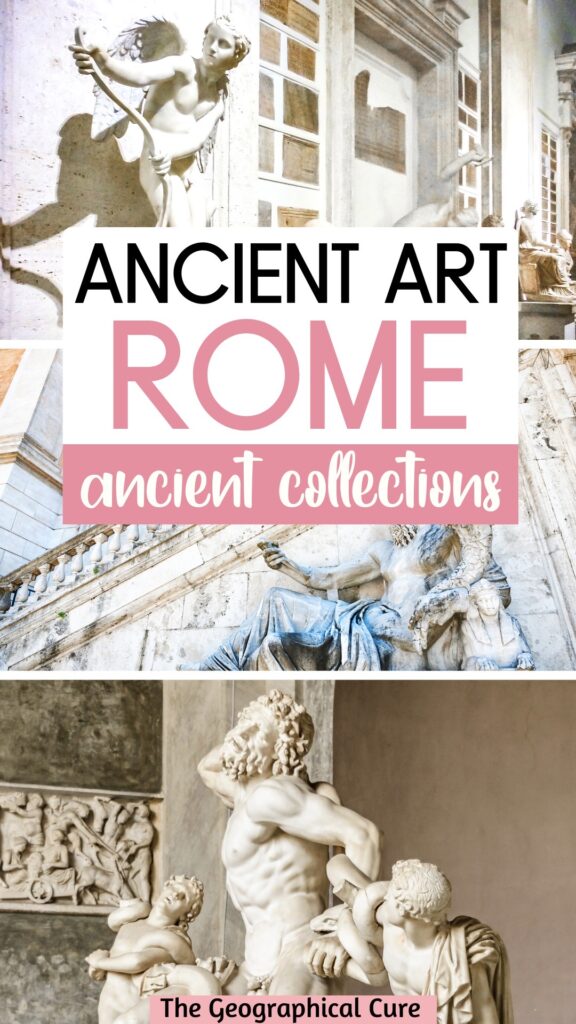
From grand sculptures and intricate mosaics to delicate frescoes and precious artifacts, Rome is a living museum that bears witness to the ancient civilizations that once thrived here.
With this guide to ancient Roman art, you’ll step into the hallowed halls of Rome’s museums and galleries. You’ll discover the enduring legacy of the Romans, the influence of the Greeks, and the remnants of other ancient civilizations that have left their mark on this remarkable city.
Ancient Art Collections In Rome
Here is an overview of Rome’s most esteemed ancient art collections and the must see masterpieces they hold.
To visit these museums, you might consider getting either the Omnia Rome & Vatican Pass or the Roma Pass.
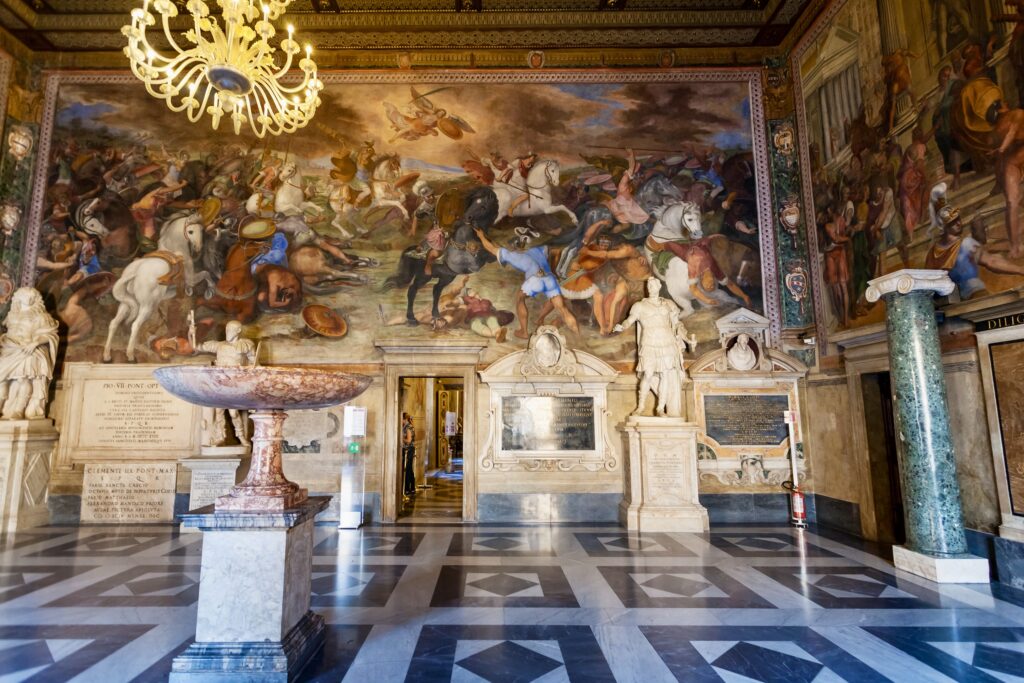
Capitoline Museums
The most important collection of ancient art in Rome is in the Capitoline Museums. It also has the most impressive location of any museum, located on a Michelangelo-designed piazza on Capitoline Hill.
The museums are spread out through the three buildings in the piazza. You enter through the building on the right, the Palazzo dei Conservatori.
The Tabularium, in the bottom of the Palazzo Senatorio, connects you to the Palazzo Nuovo. The Tabularium was once the state archives of Ancient Rome. As you pass through, you have a spectacular views of the Roman forum down below.
The first thing you see upon entering the museum is a large courtyard. It has remains of what was one of the most spectacular sculptures from Ancient Rome, a massive statue of Emperor Constantine. Just the head is 8 feet tall.
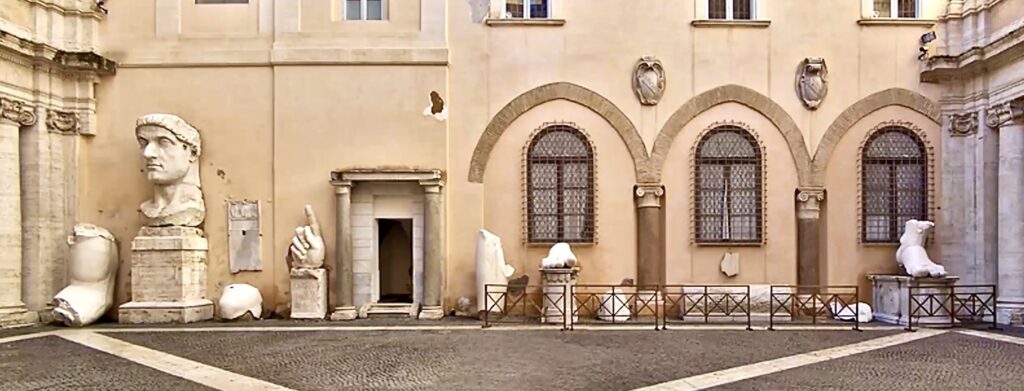
Once inside, you’ll find the Capitoline She-Wolf. The famous bronze sculpture is the very symbol of Rome. It depicts Romulus and Remus nursing from a she-wolf, part of the foundation myth of the origin of Rome.
Another celebrated sculpture is The Dying Gaul. It depicts a Galatian warrior fallen in battle. It’s famous for its theatrical and tragic representation and its anatomical accuracy.
Spinario is yet another famous sculpture, this one from the 1st century B.C. It’s an original Greek bronze sculpture, which is very rare. It became celebrated in the Renaissance as a remarkable, yet banal, scene from everyday life with extraordinary detail.
One of my other favorites is the Commodus as Hercules sculpture. He’s clad in Hercules’ trademark lion skins and carries the apples of Hesperides. It’s essentially an emperor in a superhero outfit.
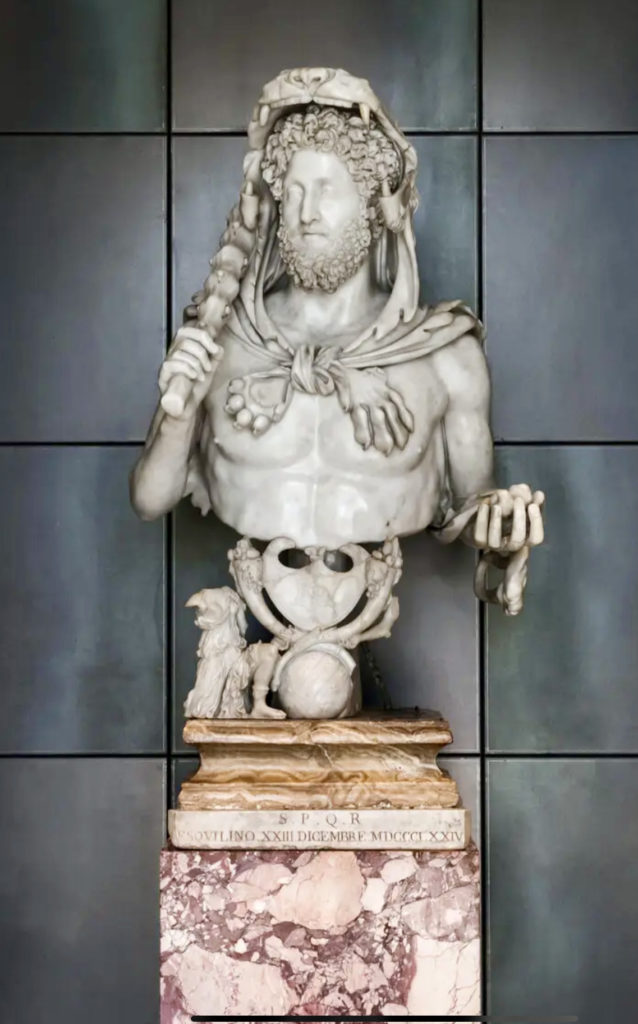
Perhaps the museum’s biggest showstopper is the Equestrian Monument to Marcus Aurelius. It’s the only surviving equestrian monument from ancient Roman times.
The bronze statue only survives (rather than being melted down) because it was mistaken for Emperor Constantine, the savior of Christianity. It’s extremely large and majestic. There is some damage from it being left outside for centuries.
Here’s my complete guide to the Capitoline Museums. In high season, you’ll want to pre-book a skip the line ticket. If you’re a true fan of ancient sculpture, you can also book a guided tour of the museum.
- Address: Piazza del Campidoglio 1
- Entry fee: € 11.50
- Hours: Daily 9:30 am to 7:30 pm
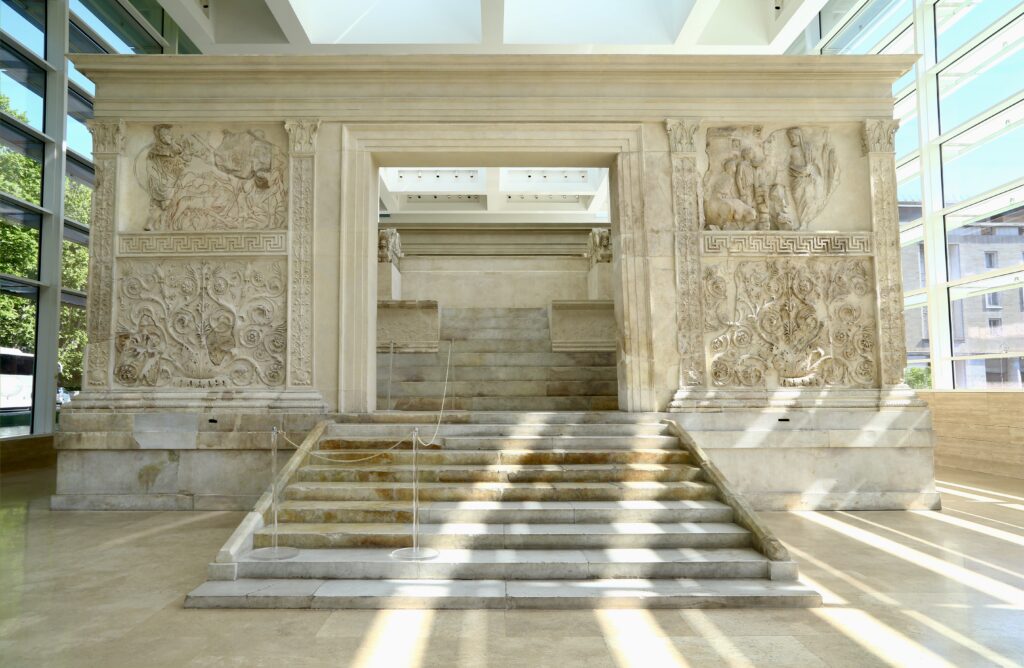
Ara Pacis Museum
The Ara Pacis Museum was inaugurated in 2006. Richard Meier designed it the building.
It was controversial for its modernity. Some thought it was a discordant style for a museum in the Eternal City. But I like the beautifully-presented combination of modern shell and 2,000 year old treasure.
Ara Pacis means altar of peace. It was commissioned by Emperor Augustus to mark the Pax Romana, a time when the Roman Empire was finally at peace.
The structure was originally near the Pantheon. But it was dismantled and moved to its current venue.
The altar is an extraordinary relief sculpture and propaganda piece. The reliefs depict various scenes that celebrate the peace and prosperity brought by Emperor Augustus. You’ll see religious processions, mythological figures, and portraits of important individuals from the time.
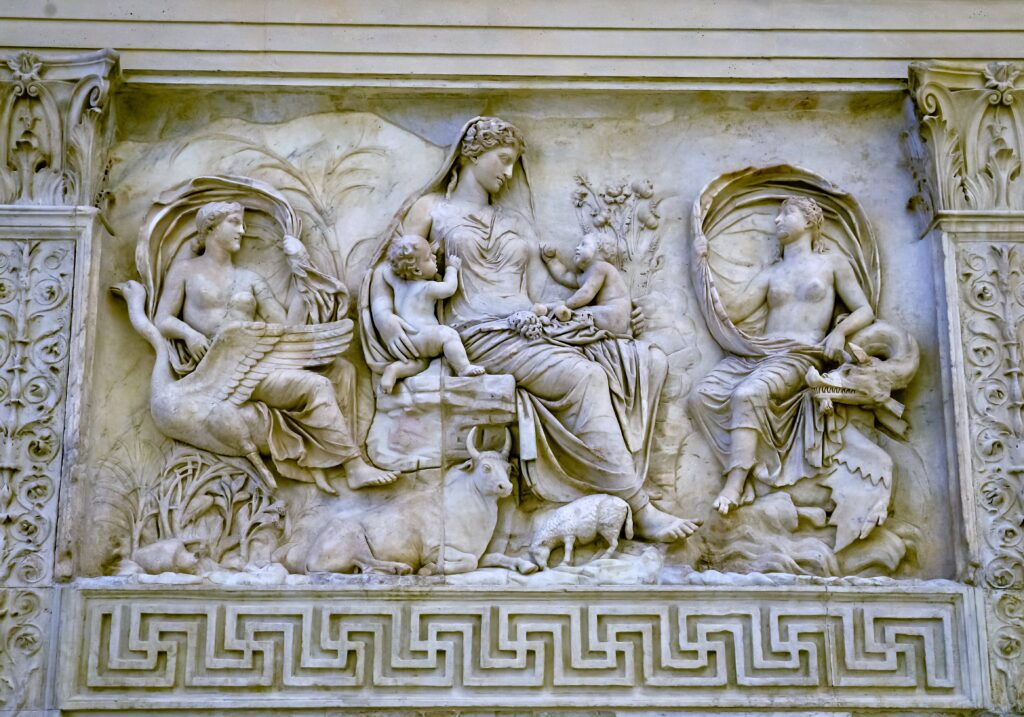
One of the most notable reliefs on the Ara Pacis is the Tellus Panel. It portrays the Roman goddess of the Earth surrounded by fertility symbols. It underscores the abundance and prosperity of the Roman Empire under Augustus’ rule.
Click here to book a skip the line ticket for the museum.
The ticket also includes entry to Augustus’ Mausoleum, which is a must visit ruin and archaeological site in Rome.
- Address: Lungotevere in Augusta Corner of Via Tomacelli
- Hours: Tuesday through Sunday 9:00 am to 7:00 pm
- Entry fee: 15 € (including exhibitions) or else 10.50 €
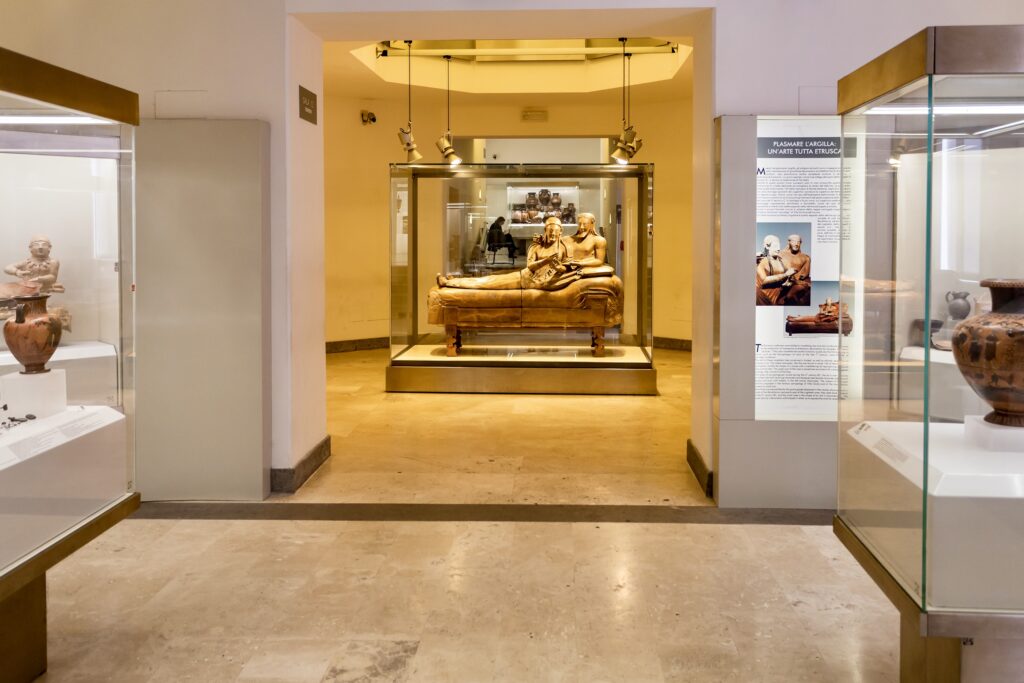
Villa Giulia
If you are a fan of Etruscan art, head to the Villa Giulia. The Etruscans pre-date the Romans. The museum holds some of the world’s most celebrated Etruscan art and artifacts.
Roman culture was based on Etruscan culture. The death of the last Etruscan king, Tarquinius Superbus, marked the end of the Roman Kingdom and the beginning of the Roman Republic.
Most of the museum’s treasures were unearthed from the Etruscan cities of Vulci, Tarquinia, and Cerveteri.
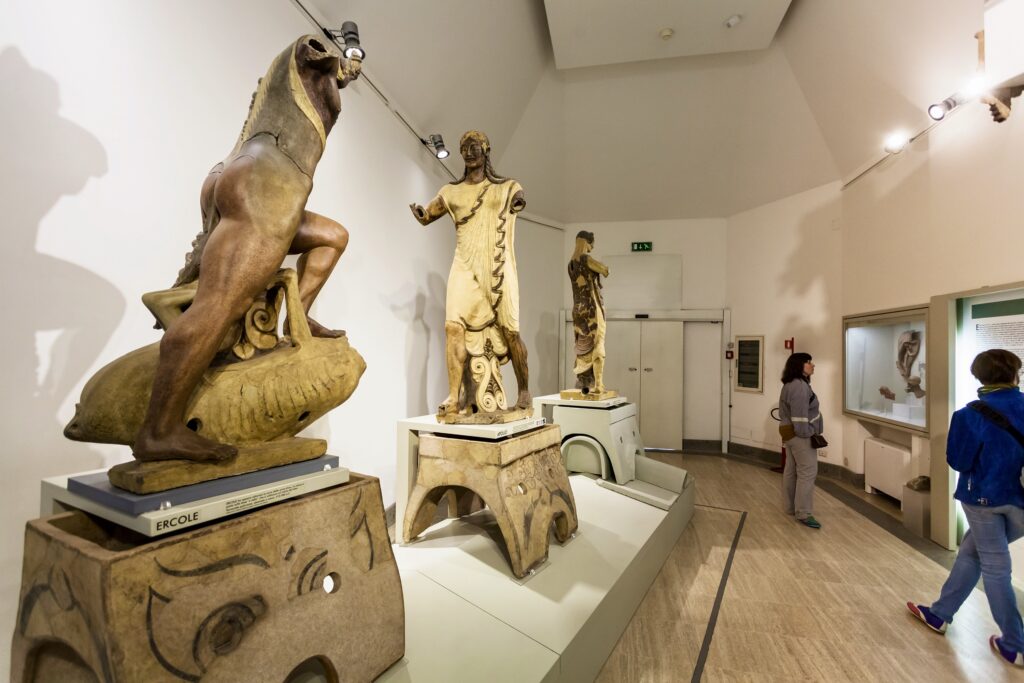
You’ll find some of the oldest examples of Etruscan writing, the Pyrgi Tablets. The golden sheets haven’t been fully deciphered yet.
One of the museum’s most famous pieces is the Sarcophagus of the Spouses from Tarquinia.
The pair are depicted joyously, as if they were reclining at a banquet to dine. For the Romans, death was not an end, just the beginning of a new reality.
Another famous Etruscan sculpture is the terracotta painted sculpture of Apollo of Vei from the 6th century B.C. The smiling god welcomes Hercules returning from his labors.
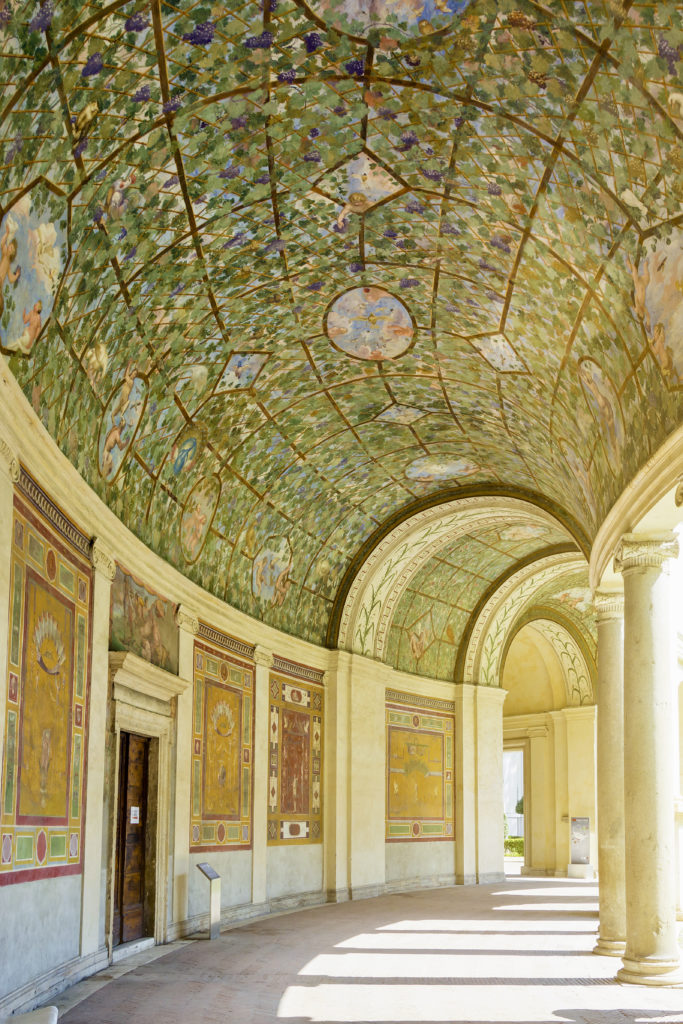
It was once on the top of an ancient Temple to Apollo. It almost look Egyptian. There were commercial ties between the Etruscan and Egyptians, so that’s not too surprising.
You’ll also find cases with red-on-black and black-on-red pottery, gold jewelry, statuettes, and a reconstructed temple relief from Pyrgi.
Click here to book a ticket for the Villa Giulia.
- Address: Via di Villa Giulia 9
- Hours: Tuesday to Sunday from 9:00 am to 8:00 pm
- Entry fee: € 10
Palazzo Massimo
The Palazzo Massimo is located right across the street from the train station. So, it’s easy to pop into if you’re traveling somewhere.
The absolute star of the collection is the ancient Boxer at Rest from the 3rd century B.C. It’s a mesmerizing sculpture of intense realism. You see a Greek athlete with wounds and cauliflower ears from the blows he’s received.
Another extraordinary thing inside the museum is the detached frescos on the top floor. They were removed from the Villa of Livia, the wife of Emperor Augustus.
Ancient paintings are very rare. There are very few examples of ancient Greco-Roman painting in the world. Most of them are in Pompeii and the Naples National Archaeological Museum.
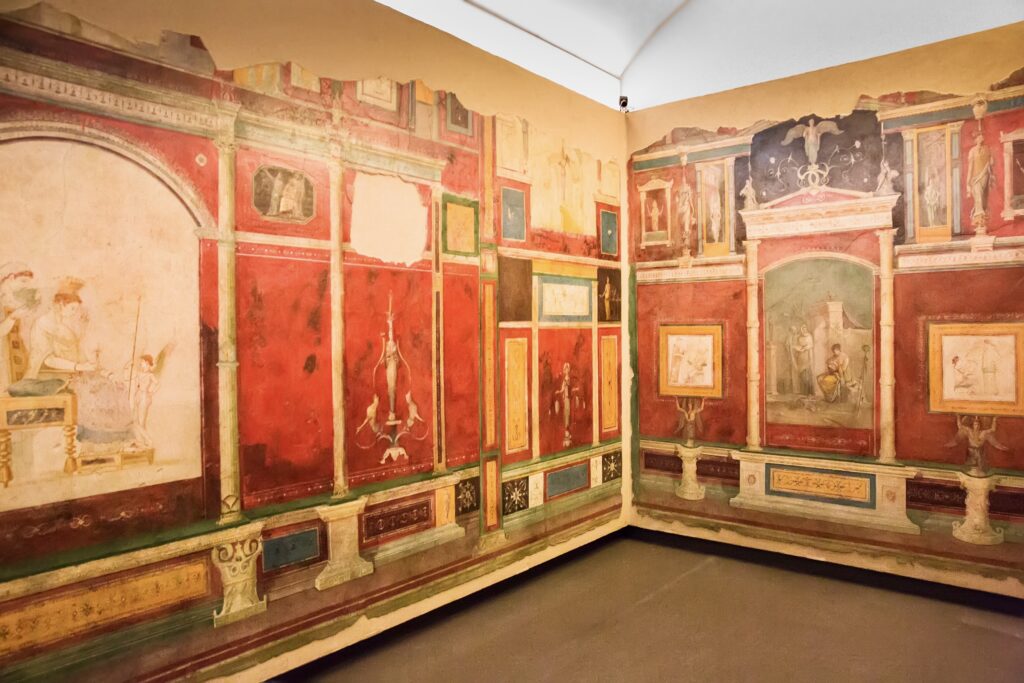
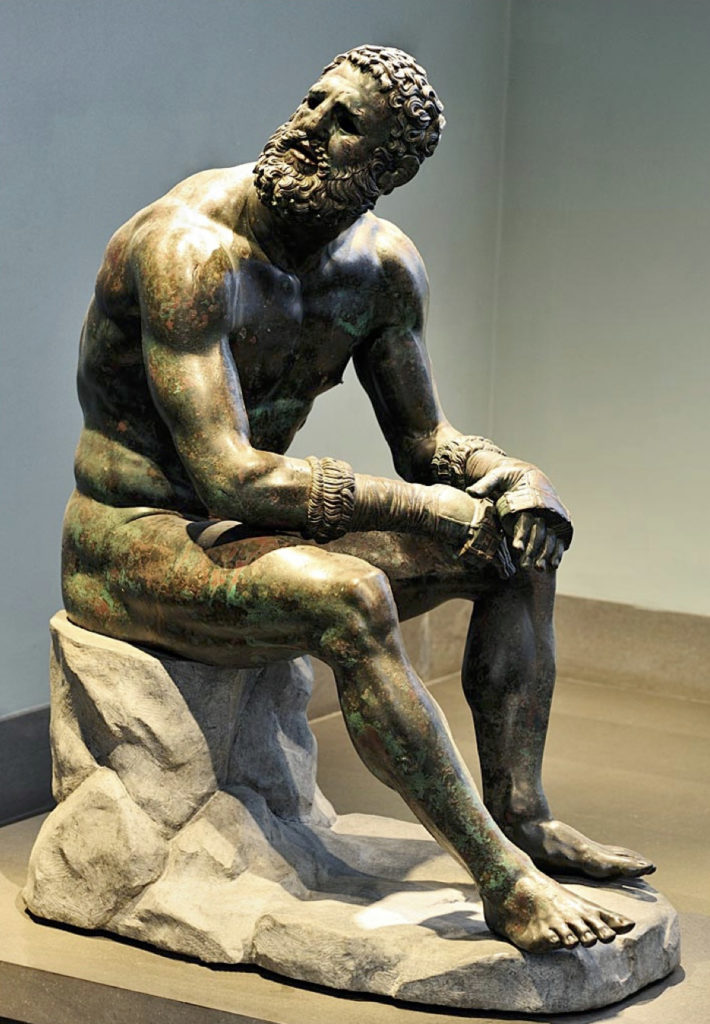
The frescos are lovely. They were illusionistic and meant to make you feel like you were outside when you were inside. There are fruit trees, laurel shrubs, flowers, pomegranates, and various birds.
There are also some Pompeiian frescos that come from the Villa Farnesina and the Villa di Termini.
On top of this, you’ll find a beautiful statue of Emperor Augustus, 1st century B.C. mosaics, sarcophagi, bas reliefs, and glass wall decorations.
The sculpture of Augustus depicts the emperor as the chief high priest, Pontifex Maximus. He’s wrapped in intricate folds of drapery. The emperor is portrayed as a youth, idealized and standing in contrapposto.
>>> Click here to book a museum tour with a PhD
- Address: Largo di Villa Peretti 2
- Hours: Tuesday to Sunday from 11:00 am to 6:00 pm
- Entry Fee: € 13
Palazzo Altemps
The 15th century Palazzo Altemps is another excellent collection of ancient art in Rome. It’s a quiet oasis where you can admire ancient sculpture without the crowds of Rome’s other museums. It’s right across from the cacophonous Piazza Navona.
Like the Palazzo Massimo, it’s part of the National Roman Museum. And like the Borghese Gallery, the collection is shown off in a gorgeous and sumptuously decorated palace. It’s amazing that this place is still a hidden gem in Rome.
At the heart of the collection lies the extraordinary Ludovisi collection, curated by Ludovico Ludovisi, nephew of Pope Gregory XV.
The must see ancient masterpieces include Apollo the Lyrist, the Ludovisi Athena, the Ludovisi Throne, the Grande Ludovisi Sarcophagus, the Ludovisi Ares, and the Ludovisi Gaul.
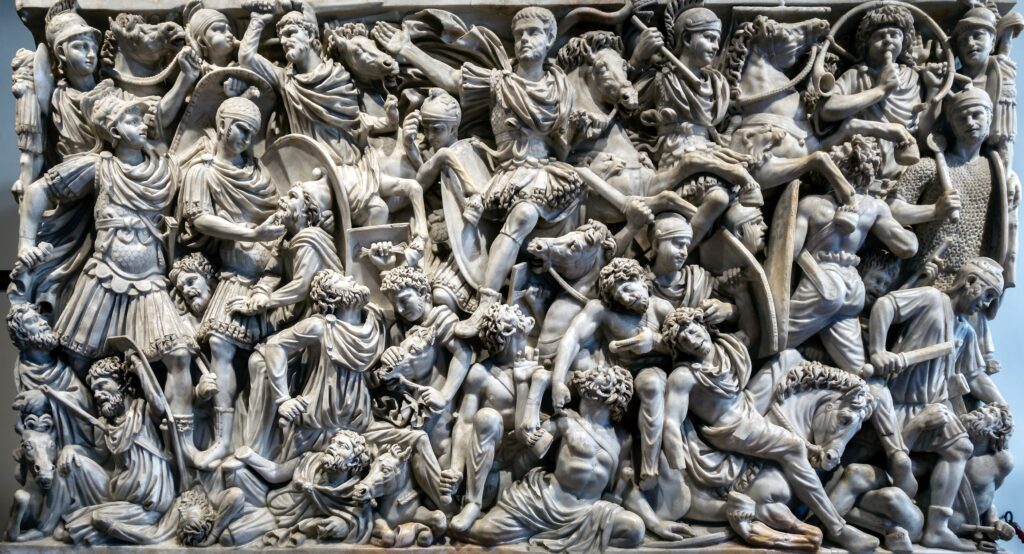
The Grand Ludovisi Sarcophagus is considered one of the finest examples of Roman imperial sarcophagi. It’s made of marble and features highly detailed and elaborate relief sculptures on all four sides.
The Ludovisi Gaul is a companion piece to the Dying Gaul in the Capitoline Museums. He’s in the process of taking his own life by thrusting a sword into his neck.
The Altemps collection in the museum is also very distinguished. It was acquired in the 16th century by an ambitious cardinal who wanted to decorate his villa in style.
In the courtyard, there are four major sculptures — Statue of Hercules, Athlete at Rest, Statue of Demeter, and Statue of Maenad. They’re Roman copies of Greek originals.
Click here to book a skip the line ticket for the museum.
- Address: Largo di Villa Peretti 2
- Hours: Tuesday to Sunday from 11:00 am to 6:00 pm
- Entry fee: € 10, combo ticket 12 euros, audio guide 5 euros
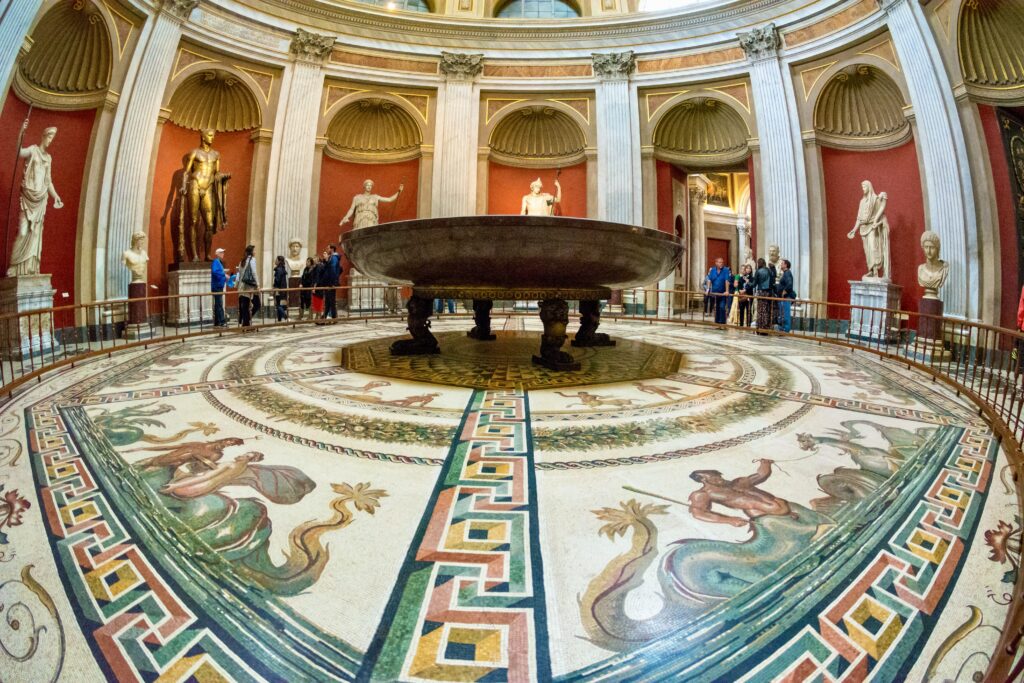
Vatican Museums
While technically not in Rome, the Vatican Museums are close enough. They are home to an extraordinary collection of ancient Roman art. Much of it is housed in the Pio-Clementine Museum.
The museum boasts a remarkable assemblage of ancient Greek and Roman sculptures that were originally part of Pope Julius II’s collection.
At the core of the museum are the Octagonal Court and the Round Hall. The Round Hall boasts an intricately crafted mosaic floor and an awe-inspiring dome reminiscent of the magnificent Pantheon.
These spaces are home to ancient sculptures like Laocoön and His Sons, Apollo Belvedere, Belvedere Torso, Colossal Statue of Hercules, Venus Felix, and Sleeping Ariadne.
READ: 20+ Famous Sculptures in the Vatican Museums
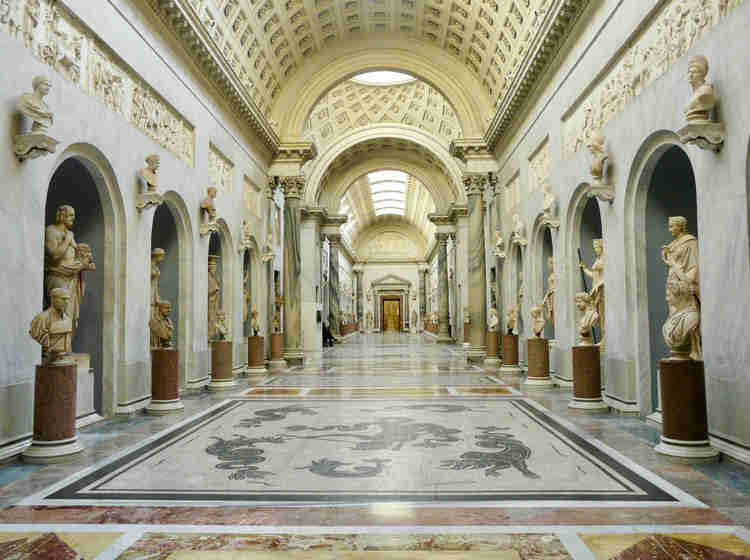
Laocoön is probably the most famous sculpture. It depicts the Trojan priest Laocoön and his sons being attacked by sea serpents.
This ancient masterpiece is renowned for its dynamic composition and realistic portrayal of human suffering.
The Gallery of Busts is also in the Pio-Clementine Museum. It’s chock full of ancient Greek-Roman marble busts and bas reliefs. They depict emperors, statesmen, and important figures from ancient Rome.
The Braccio Nuovo wing of the Chiaramonti Museum also boasts a rich collection of ancient sculptures. They include The River Nile, Augustus of Prima Porta, and The Chiaramonti Caesar.
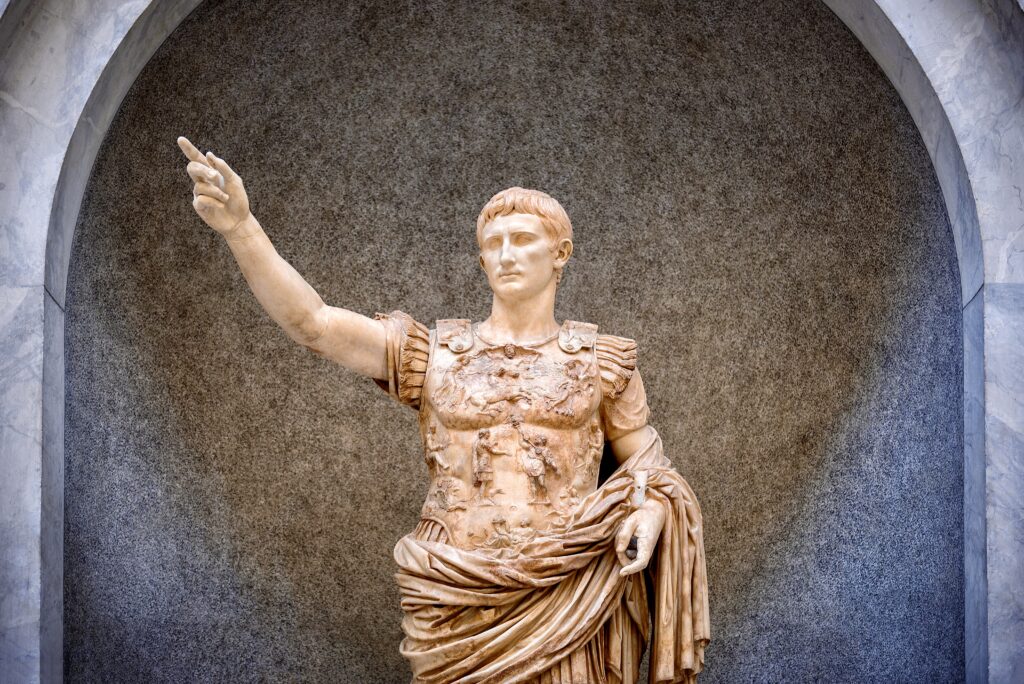
Augustus of Prima Porta was discovered in 1863 at the Villa of Livia. The sculpture depicts the emperor in a heroic pose, standing with his weight shifted onto his right leg.
He is portrayed wearing military attire, including an intricate breastplate, suggesting his role as commander and ruler of the Roman Empire.
You absolutely must pre-book a skip the line ticket to visit the Vatican Museums. I recommend this 3 hour no wait tour that also includes the Raphael Rooms or this 3.5 hour tour Vatican visit with a guided tour of St. Peter’s Basilica.
- Address: 00120 Vatican City
- Hours: Monday to Saturday, 9:00 am to 6:00 pm
- Entry fee: € 17
I hope you’ve enjoyed my guide to the ancient art collections of Rome. You may enjoy these other Rome travel guides and resources.
- 8 ways to spend 1 day in Rome
- 3 day itinerary for Rome
- 4 day itinerary for Rome
- 5 day itinerary for Rome
- Hidden gems in Rome
- Archaeological sites in Rome
- Guide to the Borghese Gallery
- Guide to Palatine Hill
- Guide to the Roman Forum
- Guide to the Colosseum
Pin it for later.

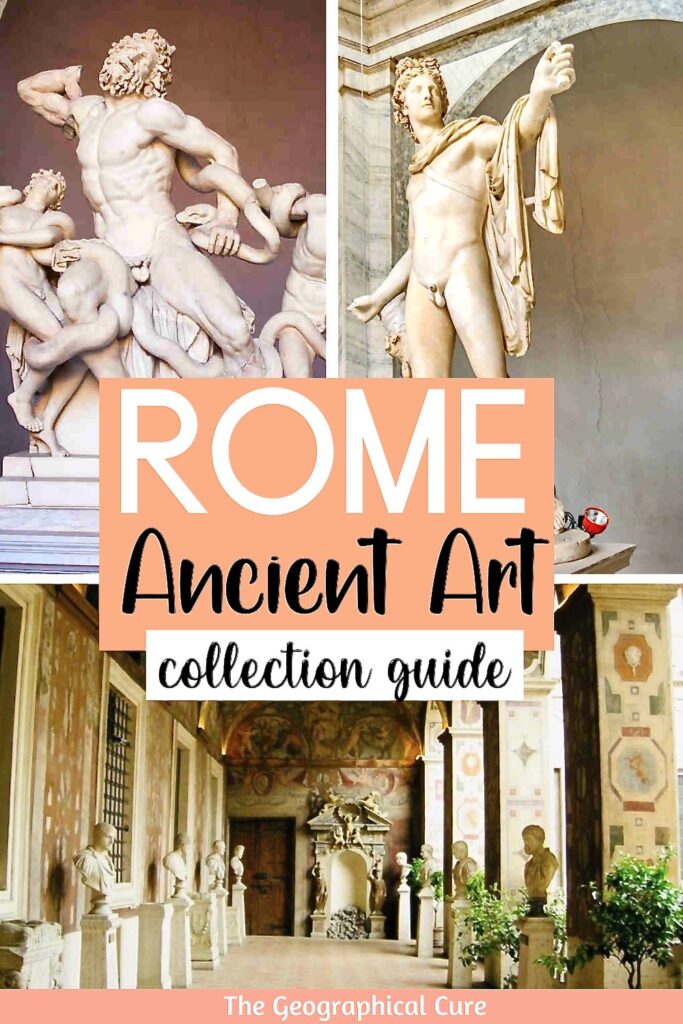
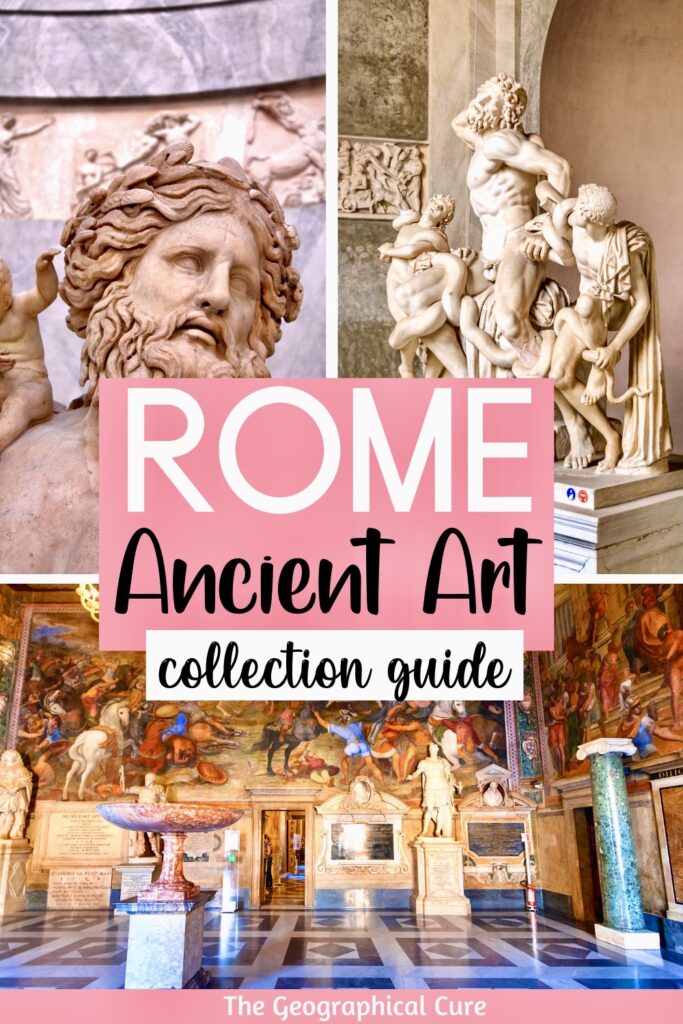
To the list I would add the Baracco, smaller than the others mentionned but interesting none the less.
Then there is the oft forgotten Museo dell’Alto Medioevo which has a remarquable selection of late roman (4th to 7th century) pieces of art.
One may also mention the Aristaios museum in the buildings of the Auditorium Parco della Musica : not only does it cover the evolution of a local rural settlement, but it offers a nice selection of ancient Greek vases.
The Case Romane del Celio also host an interesting museum with a number of ancient industry related themes not covered in the “traditional” ancient art collections.